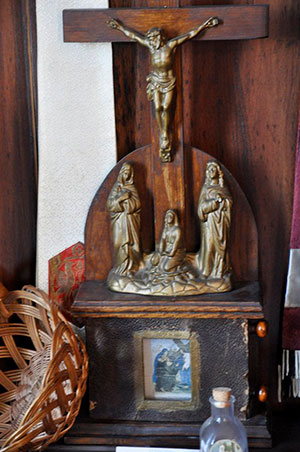 Bishop David L. Ricken of Green Bay, Wis., former chairman of the Committee on Evangelization and Catechesis of the U.S. Conference of Catholic Bishops, offers “10 Things to Remember for Lent”:
Bishop David L. Ricken of Green Bay, Wis., former chairman of the Committee on Evangelization and Catechesis of the U.S. Conference of Catholic Bishops, offers “10 Things to Remember for Lent”:
1. Remember the formula. The Church does a good job capturing certain truths with easy-to-remember lists and formulas: 10 Commandments, 7 sacraments, 3 persons in the Trinity. For Lent, the Church gives us almost a slogan—Prayer, Fasting and Almsgiving—as the three things we need to work on during the season.
2. It’s a time of prayer. Lent is essentially an act of prayer spread out over 40 days. As we pray, we go on a journey, one that hopefully brings us closer to Christ and leaves us changed by the encounter with Him.
3. It’s a time to fast. With the fasts of Ash Wednesday and Good Friday, meatless Fridays, and our personal disciplines interspersed, Lent is the only time many Catholics these days actually fast. And maybe that’s why it gets all the attention. “What are you giving up for Lent? Hotdogs? Beer? Jelly beans?” It’s almost a game for some of us, but fasting is actually a form of penance, which helps us turn away from sin and toward Christ.
4. It’s a time to work on discipline. The 40 days of Lent are also a good, set time to work on personal discipline in general. Instead of giving something up, it can be doing something positive. “I’m going to exercise more. I’m going to pray more. I’m going to be nicer to my family, friends and coworkers.”
5. It’s about dying to yourself. The more serious side of Lenten discipline is that it’s about more than self-control – it’s about finding aspects of yourself that are less than Christ-like and letting them die. The suffering and death of Christ are foremost on our minds during Lent, and we join in these mysteries by suffering, dying with Christ and being resurrected in a purified form.
6. Don’t do too much. It’s tempting to make Lent some ambitious period of personal reinvention, but it’s best to keep it simple and focused. There’s a reason the Church works on these mysteries year after year. We spend our entire lives growing closer to God. Don’t try to cram it all in one Lent. That’s a recipe for failure.
7. Lent reminds us of our weakness. Of course, even when we set simple goals for ourselves during Lent, we still have trouble keeping them. When we fast, we realize we’re all just one meal away from hunger. In both cases, Lent shows us our weakness. This can be painful, but recognizing how helpless we are makes us seek God’s help with renewed urgency and sincerity.
8. Be patient with yourself. When we’re confronted with our own weakness during Lent, the temptation is to get angry and frustrated. “What a bad person I am!” But that’s the wrong lesson. God is calling us to be patient and to see ourselves as He does, with unconditional love.
9. Reach out in charity. As we experience weakness and suffering during Lent, we should be renewed in our compassion for those who are hungry, suffering or otherwise in need. The third part of the Lenten formula is almsgiving. It’s about more than throwing a few extra dollars in the collection plate; it’s about reaching out to others and helping them without question as a way of sharing the experience of God’s unconditional love.
10. Learn to love like Christ. Giving of ourselves in the midst of our suffering and self-denial brings us closer to loving like Christ, who suffered and poured Himself out unconditionally on cross for all of us. Lent is a journey through the desert to the foot of the cross on Good Friday, as we seek Him out, ask His help, join in His suffering, and learn to love like Him.
— U.S. Conference of Catholic Bishops. Find more Lenten resources at https://www.usccb.org/prayer-and-worship/liturgical-year-and-calendar/lent
The Italian tradition of a St. Joseph Table is a popular devotion for the Feast of St. Joseph.
The “Tavola di San Giuseppe” (“St. Joseph’s Table” or “St. Joseph’s Altar”) originated in Sicily, which claims St. Joseph as its patron. It is practiced on March 19, the feast of St. Joseph. March 19 is also Father’s Day in Italy, which is fitting as St. Joseph was the foster father of Jesus.
This celebration featuring a makeshift shrine is a symbolic “thank you” and renewal of the Sicilian people’s devotion to St. Joseph.
It is a shared or communal celebration, in which the riches of food are given as alms to the poor and no one can be turned away. It has three aspects: veneration, special recognition of St. Joseph during Mass and at the “table”; the table, both a kind of “altar of reverence” and a communal celebration; and the poor, with the intention that the gathered food will help people in need.
Here’s how to set up your own St. Joseph Table at home or at your parish:
STEP 1: Choose a date and invite guests. If March 19 is not possible, celebrating a day or two before or afterwards is OK. It is ideal to host the celebration after Mass. Invite guests, especially children to dress up and play the parts of the Holy Family, the Apostles and angels. Guests should bring decorations or food items for the table.
STEP 2: Set up the table. Place a table in a prominent location of your home or church. On the table, arrange at least two display tiers using durable boxes or small shelves. (The three tiers represent the Holy Trinity, and the ascent from earth to heaven.) Cover the table and tiers with a white tablecloth.
STEP 3: Decorate the table. Place a statue of St. Joseph on the top tier. On the other tiers, display flowers (white lilies, in particular), candles, statues, rosaries and holy cards. The setup should be solemn and festive – use your imagination! Vigil lights of green, brown and yellow (representing St. Joseph’s clothing) can be placed all around, and the table can be surrounded by palms reminiscent of the Holy Land.
STEP 4: Set out a basket to collect prayer intentions and alms for the poor. You might collect canned goods for a food pantry or have a cash donation basket.
STEP 5: Prepare the menu. One traditional main dish in Sicily is “Carpenter’s Pasta” – pasta made with bread crumbs sautéed in butter to resemble sawdust – but you can include fish, soups or other pasta. Cheese isn’t used, symbolic of the food shortage experienced in the origin legend of the tradition. Sesame-coated artisan breads in symbolic shapes are a key centerpiece of the table and the menu. Don’t forget to include dessert: cakes, biscotti and cookies embellished with almonds are common. For menu ideas, go to www.yearofstjoseph.org.
STEP 6: Gather and place specific foods on the table. Special breads, fruits, vegetables, baked goods, pasta, wine and olives are all traditional items found on a St. Joseph’s Table. But as it is Lent, omit any meats and cheeses. Arriving guests should place their items on or around the table.
STEP 7: Bless the St. Joseph Table. Before or at the start of your celebration, invite a priest or deacon to bless your table, or pray together as a family.
STEP 8: Eat. The three children representing the Holy Family eat first, and they sit at a small table reserved just for them. Food is served buffet style.
STEP 9: Pray. After the meal, pray together as a group, seeking St. Joseph’s intercession. Pray the Litany to St. Joseph or use the diocese’s St. Joseph Prayer Book for other ideas. To end the celebration, offer guests a small gift such as a St. Joseph holy card. When possible, deliver the items collected for the poor to conclude the devotion.
— SueAnn Howell, Senior reporter. www.yearofstjoseph.org and Tom Sperrazzo contributed.
Learn more
For detailed information about the tradition and the setting of the St. Joseph’s Table, go online to the Year of St. Joseph website at www.yearofstjoseph.org/devotions/st-joseph-table. If you live in the Charlotte area and want to order baked goods and specialty items for the March 19 feast day, contact Tom Sperrazzo at This email address is being protected from spambots. You need JavaScript enabled to view it. or call 980-253-2650.


